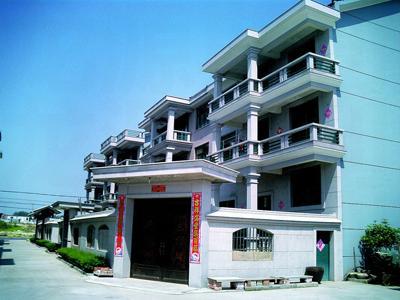Huge Changes in Village Called Wangfeng
2009-05-11WeiXilongLuXiaoyan
Wei Xilong Lu Xiaoyan

Take a look at the village of Wangfeng and you will never imagine what it looked like a few years ago. Even its previous name Wangkeng does not suggest anything if you do not know what changes the village has experienced.
Travel down Xueshi Avenue of Dongyang, an industrialized city in central Zhejiang, and you will find Wangfeng Village at the end of the road. Unlike what you see all the way from downtown where construction sites abound everywhere, the quiet village unfolds its modern and yet classical architecture under the blue sky. Arrays of villa-styled houses are crisscrossed by wide cement roads; on the village center is a square where old people lounge and kids frolic.
The name Wangfeng in the Chinese language suggests hills or peaks. But you cant see any hills there. But two low hills did stand near the village before the village started an unprecedented and daredevil project in 2006.
Before 2006, the village was trapped in a low basin. The ground was so uneven that some houses were eight meters above some other houses. The village was called Wangkeng in bad old days. Keng in the name suggested holes in the ground. Villagers hated the name so much that they voted to change the name to Wangfeng in the late 1970s. However, the new name did not bring immediate changes. Before 1994, all houses in the village were structures of earth and wood. The village was connected with the outside world with a dirt road only wide enough for tractors. In rainy days, the road was a nightmare. In dry days, dust flew whenever a tractor passed. Even an ambulance could not reach the village in rainy days.
With the new name, village was still a laughing stock among the people in neighboring villages. “You are still in a hole even if the village is not called Wangkeng anymore.” It was a bad joke and many villagers of Wangfeng hated it.

However, the village economy improved a great deal thanks to the economic takeoff of Dongyang. In 2006, the village management pondered options available for them as the city launched a general campaign to improve village infrastructures. The village planners knew constraints everywhere. The geographic conditions gave them no good options at all. All the houses clustered together and roads in the village were narrow. Where was the land for a flat ground where a new village could spread out and enjoy space and sunlight? The planners eyeballed the two hills. What if they were removed? The space to be vacated by the two hills could provide adequate space for houses, roads, woods, a village square and other public facilities.
The idea was very attractive. But villagers were pragmatic enough to ask where to dump the removed hills. A bold idea was to put all the earth and rocks into the holes where the village was trapped. Many villagers instantly became hostile to the new idea, for the new idea could mean that all the houses in the village must be dismantled. Many redbrick houses, four or five stories in height, were just new. Some villagers were so angry that they seized the management and asked what if new houses could never materialize. Village heads promised that they would dismantle their houses first and they would sleep outdoors if they failed to give villagers houses as promised.

Seeing the alluring blueprint and determined village heads, villagers made up their minds and agreed to the bold project. May 10, 2006 was the big day in Wangfeng. The villagers began to vacate and the mountain-removal project kicked off.In less than a year, the two hills were removed and the holes were filled up. The total village ground averaged four meters higher than before.
Using an overall blueprint was a matter of fairness and openness. The villa-styled houses in the best location of the village were allocated to the 69 households which sustained the heaviest economic losses in the new-village project. In order to be fair, a special design was adopted to have two households in one unit. Each unit has 8-meter-wide roads in four sides and has a garden which is 8 meters long. All the houses use the same outer wall paints and all the houses use the same building standards and the same external design. And all the houses are tied into the same infrastructure system.
The new village has space for public facilities. Wangfeng Village boasts a garden with a pond, a basketball court and a volleyball court, a jogging path, and a dancing court. The village now also boasts a sports and culture center with a library, a computer room, a rehearsal room, a ping-pong room, a poker and mahjong room and a movie theater. The villagers have organized themselves into various sports clubs.
Wangfeng Village enjoys a moderately wealthy life. The village has a population of 516 in 176 households. The per capita income in 2008 was 16,800 yuan. Part of the new village ground now is real estate rented out as workshops for businesses. The rents are distributed to villagers. All the villagers are now covered in medical insurance and land insurance paid by the village coffer.
Nowadays, Wangfeng Village is no longer a laughing stock. It is a model for its flourishing cultural undertakings and a model of socialist new countryside. □
